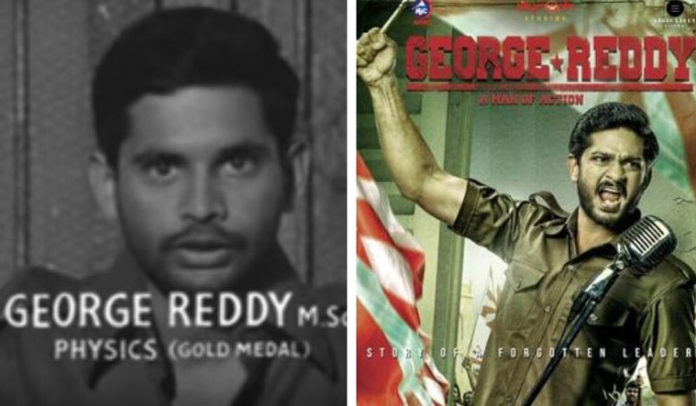When a society is starved of culture, they lap up whatever is presented to them in its name. Feature Films have been one of the main staples in the Telugu Cultural landscape. But, one look at the present set of films would give us a glimpse of what is presented in the name of culture and entertainment. Arts has ended up being a money-making industry with no connect with art or culture.
As I write this, students in many universities are demonised for protesting against fee hike. Such a society that speaks of demographic dividend but lets its youth be either jobless or at the door of corporate education can only produce ‘dead culture’.
It suffices to say that the Telugu film industry of today embodies such ‘dead culture’ in its lowliest form, and that too with huge viewership. But even in such a parched landscape once in a while we get to see a rare flowering. The last time it happened was one year back. Now once again we are lured towards that ritual in the form of George Reddy.
George Reddy Film, lest we make the mistake, is neither biopic of George Reddy nor a historical fiction based on his life and work. It was simply a film inspired by the life of the Radical Students’ Leader from Osmania University, Challa George Reddy. George Reddy, a charismatic student leader from Osmania University was murdered by the Sanghis when he almost decided to become a professional Revolutionary in those heydays of Naxalite Movement. Son of a Malayali Mother and Reddy Father from Chittor District, he spent his childhood in Kerala before moving back to Hyderabad with his mother. Though his father hails from a landlord family, the communist influence was no alien to George. His uncle was a well-respected Communist in Andhra Pradesh. A brilliant student, he was awarded gold medal for his performance in studies and keeping up with the spirit of the times of the Spring Thunder rejected all the brilliant opportunities that had come flying in his way. A brief understanding of Telangana of that time would necessitate appreciating the context of the film. The cultural and to a considerable extent the feudal economic relations were still ruling the roost in the Telangana region. It was the time when the armed movement was establishing itself in the rural hinterlands of Telangana, and to some extent in Andhra Pradesh. The armed movement, inspired by the Naxalbari struggle and the Srikakulam Peasants’ Armed Struggle, had its support base mostly from the exploited sections in the Telangana. Whatever the merits or demerits of the movement, we have to accept the impact it had on society and more importantly on the minds of the budding youngsters of that time. As brilliantly pointed out by K. Balagopal, Naxalites despite their theoretical aversion towards ‘Caste Question’ and their stated opposition to the Constitution were mainly responsible for democratizing the society and making sure that the progressive constitutional prerogatives were implemented in this country, mainly so in areas such as Telangana. It was in that context that the brilliant students and many youngsters like George Reddy left their lucrative careers and jumped headlong into the struggle. It was also the time when the hitherto excluded sections started coming to the University spaces. This is sort of peculiar to Telangana. Andhra Pradesh being under the colonial role got a head start in many aspects, education was one among them. Universities to which students from oppressed sections go can never be isolated islands like what these proliferating Private Universities are proving to be. So was Osmania University. The setting of the movie is at this particular University.
Coming to the film, the film should be seen as a symbolic representation of the Revolutionary. The film too is filled with symbolism, though most of the symbolic shots are drab and dry. ABCD for ABVP, for example. The one good shot is the framed photo of Vivekananda in the background of the ABCD’s office. The struggles in the University were merely limited to the strictly campus-related issues when the fight in the Osmania University was heavily in the nature of anti-feudal. The trickling of students from the oppressed communities started around the same time. The push back from the feudal sections represented by the students who were sons of the feudal lords is morphed into control over campus electoral politics. Such a reduction is in bad taste. It could have been dealt in a better manner. Also, the point that Feudal elements supported by RSS were also from the Reddy community is visibly missing in the movie. Perhaps, a conscious decision (It needs to be said that the filmmaker, as well as the producers of the movie, are Reddys). The regressive elements in the campus were merely limited to the rowdies from the Hyderabad city hell-bent on preserving their domination in the campus. Importantly, the film’s greatest crime is reducing the broader struggle of George and his companions to campus electoral political quibbling. Nonetheless, it is admirable that ‘Bharat Mata ki Jai’ slogan and the stock phrases and narratives of the Saghis (such as We have to protect our culture from these Muslims, We have to teach a lesson to the Pakistani dogs, etc) have been portrayed consistently as an aide to the politics of the ABCD union. Making such use of ‘Bharat Mata ki Jai’ slogan is truly admirable when even refusal to chant that slogan has become a death confirming act. But for some reason, the film team felt pressurized to make clear that they weren’t rooting for armed struggles. Such moralizing is unnecessary. They should have known that there were many ‘Naxalite movies’ in Telugu and few of them were indeed box-office hits. Not that one would actively root for such struggles, but the movie need not be intrusive- that too with drab symbolic shots- moralistic is my point.
Being a film that was expected to return profits, crass, patriarchal portrayal of women is all over the place. That’s the tragedy we were talking about above. Be it whatever, the element has to be portrayed. The film starts with a haughty academic researcher intent on ‘rectifying’ the history of George’s work lands up in Telangana to dig up the history. The life of George unfolds since then on the screen with the haughty researcher appearing once in a while in the frame. It is mostly a description of George’s life by his acquaintances. The film could have been 10-15 minutes less in duration.
All in all, one shouldn’t waste time quibbling over the historical inaccuracies in the movie. This movie was not made for Leftists of various sorts to trash out the historical details. This movie needs to be seen as introducing the forgotten legacy of opposition to the Fascists. If it succeeds even a bit in that the film would have achieved its stated purpose.
Author is an activist with Human Rights forum (HRF) Andhra pradesh.
Disclaimer: The views and opinions expressed in this blog are those of the author and do not reflect the policy of the website.




























